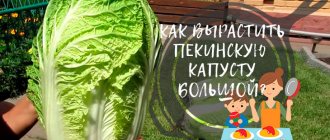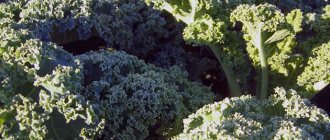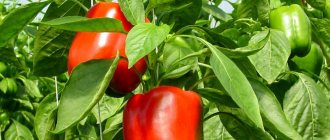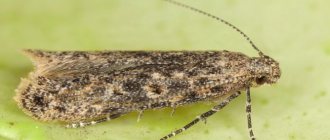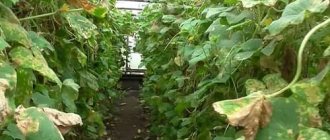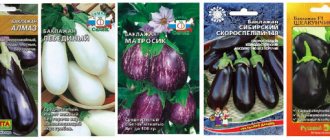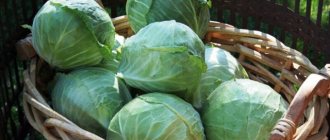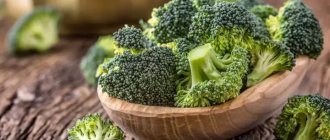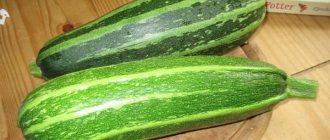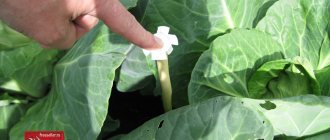Cabbage varieties and hybrids for central Russia can be successfully grown in the Far East, Southern Urals, and southern Western Siberia. Therefore, most varieties for the middle zone are grown in these regions. But at the same time, here in Russia there are cold climatic zones. And therefore, to grow cabbage in these regions, varieties specially adapted for these places are needed. And this is precisely what Russian breeders are currently working on.
Cabbage varieties are early-ripening, mid-ripening and late-ripening. However, they all differ in the vegetative period of maturation. Therefore, the agricultural conditions for growing cabbage differ among them. Thus, you must understand what kind of cabbage you want to end up with. Here, you need to proceed from your tastes and wishes.
See the table for the types of cabbage:
Variety Ripening period Early ripening 70 - 105 days Mid ripening 80 - 115 days Late ripening 165 - 180 days
The best early ripening varieties of cabbage
“Early cabbage” - the name speaks for itself. The growing season for early cabbage is 70 - 105 days (this period is calculated from the emergence of seedlings to harvest). Moreover, if everything is done correctly, at the end of June you will reap the first harvest of this crop. Basically, early cabbage is used for fresh consumption in the form of salads. You can also use it to make cabbage soup, solyanka, and soups. Also, it is used as a side dish for any dishes.
Early cabbage does not have much cabbage weight; this applies to almost all varieties and hybrids for this plant. But, there are exceptions. Read carefully. It should be noted that this cabbage cannot be fermented and stored in winter. At the same time, it must be collected on time, otherwise it will crack (there are exceptions; look carefully at the varieties listed below.).
June
An early variety with a ripening period of 90 - 100 days from germination to cutting.
Advantages:
- Early ripening.
- Resistant to cracking. Frequent watering does not harm.
- Frost resistance: seedlings tolerate frost down to minus two degrees, and adult plants up to minus five. This promotes the use of this variety throughout almost the entire territory of Russia.
- He is not afraid of the cabbage fly.
- Good yield.
Cossack F1
The vegetative period is 95 - 110 days. Here, from planting seedlings to harvesting, it takes 45 - 55 days. Weight up to 1.5 kg.
- Excellent taste.
- Immune to blackleg and mucous bacteriosis. Moderately resistant to clubroot and vascular bacteriosis.
- The culture matures at the same time.
- Stores quite well: up to 6 months.
- Resistant to cracking.
- Can't stand the heat
- Doesn't like shadows.
Parel F1
The vegetative period is 100 - 105 days, after planting and before harvesting it takes 55 - 60 days. Fruit weight 1 - 1.8 kg.
Advantages:
- You can get extra early products.
- Friendly maturation.
- Easily tolerates heat and cold.
- Not prone to cracking.
- A small stalk.
- Storage in winter is not possible.
Ditmarskaya Early
The vegetative period is 105 days, with 65 days passing from planting seedlings to harvesting them. Weight 1.5 - 2 kg.
Advantages:
- A small stalk.
- They are disease resistant for cruciferous crops and also resist various pests well.
- Prone to cracking.
When technical ripeness is achieved, the crop should be harvested, otherwise it may crack.
Golden hectare
The growing season is 110 days. Weight up to 2.5 kg.
Advantages:
- A small stalk.
- Resistant to clubroot and drought. Other diseases can overcome, so prevention is needed.
- Cabbage can be stored for up to 5 months; it is suitable for canning.
- It almost does not crack, so it is not afraid of untimely cleaning.
- Requires fertile soil.
Demanding on soil: does not grow in poor soils. The soil must be fertile.
Copenhagen Market
Vegetation period is 100 days, weighs up to 2.5 kg. The variety was bred in Denmark.
Advantages:
- A small stalk.
- Early.
- Does not shoot or crack.
- Easily tolerates light frosts.
- Poorly stored, only 3 - 4 weeks after harvesting.
Dumas F1
It ripens in 90 days - it is an ultra-early hybrid, and weighs up to 1.5 kg.
Advantages:
- Ultra early ripening.
- Not subject to cracking.
- Grows in dense plantings.
- Cabbage cannot be stored for a long time.
Transfer F1
The vegetative period is 110 days with the cabbage weight not exceeding 1.5 kg. From planting seedlings to harvesting 50 - 55 days.
Advantages:
- Friendly return of the harvest.
- Frost resistance.
- Super early
- Relatively resistant to diseases and pests.
- Resistant to cracking.
- Storage is the same as for all early varieties.
Malachite F1
The early hybrid matures in 100 days. Weight up to 2 kg.
Advantages:
- Does not crack.
- Resistant to diseases and pests.
Varieties for different regions
Cabbage is grown in areas with different climatic conditions. To get the best results, it is recommended to select varieties that meet the requirements of a particular region. For this, a number of factors are taken into account:
- length of daylight hours;
- duration of summer;
- regularity and amount of precipitation;
- possible temperature changes.
For southern regions
TOP 7 varieties ideal for cultivation in the south of the country:
- Aigul cabbage – ripening 60 days, weight 1.1 kg, productivity 280 c/ha, high taste and marketability, resistance to major diseases and drought.
- Flash - ripening up to 100 days, weight 2 kg, yield 6.5 kg/m2, excellent taste, sugar content, elastic pulp. Immunity to fusarium, not prone to cracking, high commercial characteristics allowing commercial cultivation.
- Eliza - ripening 55 days, weight 1.5 kg, yield 6 kg/m2, marketability of at least 94%, excellent taste, possibility of transportation. Resistance to rotting, resistance to low temperatures.
- Grace - ripening 120 days, weight 3 kg, yield 84 t/ha, unpretentiousness to weather conditions, resistance to thrips, vascular bacteriosis and fusarium. Excellent taste, can be consumed fresh, and can be processed.
- Samur 2 – ripening 140 days, weight 1.5 kg, productivity 4.5 kg/m2, cold resistance, non-bolting. Good taste and product characteristics.
- Jeant – ripening 120 days, weight 4-6 kg, ability to quickly adapt to different growing conditions, non-cracking, transportability. The yield is 460 c/ha, the yield of marketable products is not less than 92%.
- Yuzhanka 31 – late ripening, weight 3 kg, productivity 700-1000 c/ha, suitable for commercial production. Excellent taste and product characteristics.
Mid-season cabbage varieties and hybrids
Slava 1305
The vegetative ripening period is 100 - 125 days, 80 - 95 days after planting the seedlings, while the heads of cabbage reach a weight of 4.5 kg. Advantages:
- Easily tolerates drought.
- Quite resistant to diseases and pests.
- It does not crack when overripe.
- Cabbage can be stored for no more than 3 months.
Belorusskaya 455
Vegetation period is 120 - 130 days, with a fruit weight of up to 4 kg.
Advantages:
- Does not crack.
- Resistant to low temperatures.
- A small stalk.
- Perfectly transportable.
- High yield.
Hope
The full ripening period is 110 - 130 days, with an average weight of kernels up to 3.5 kilograms.
Advantages:
- Not prone to cracking.
- Not afraid of cold weather.
- Has immunity to diseases and pests.
- Storage no more than 3 months after collection.
Mid-late cabbage varieties and hybrids
Present
The vegetative period is 115 - 134 days. Average weight 2.5 kg. - 4.5 kg.
Advantages:
- Excellent immunity from pests and diseases.
- Tolerates the cold very well.
- Transportability is excellent.
- High yields provided proper agricultural practices are followed.
- It can be stored for only up to 5 months, although this is not bad at all and I don’t want to call it a disadvantage.
A time-tested variety you can rely on. It's not easy to find flaws in it.
Judge 146
Full ripening occurs in 130 - 150 days (counted from sowing seeds to harvesting), with a yield of 5 - 6.6 kg/m.
Advantages:
- Tolerates drought well.
- Not prone to cracking.
- Disease resistant.
- You can store cabbage until spring.
Foreman F1
Maturity occurs in 110 - 120 days, and the fruits weigh up to 3.5 kg. average.
Advantages:
- Resistant to dry weather.
- Resists cracking for 4 - 6 weeks after ripening.
- Good immunity to diseases
- Storage is possible only for 4 - 5 months, and I don’t want to call this a disadvantage.
Krautman F1
Full ripeness occurs in 120 - 140 days. At the same time, on average, heads of cabbage weigh up to 4 kg, although they can be more if you try.
Advantages:
- The taste is excellent.
- Stored until March.
- Immune to fungal diseases.
Aggressor F1
Full ripeness occurs in 120 - 130 days, and the weight reaches up to 5 kg.
Advantages:
- Unpretentious. Therefore, it can be grown in different climatic zones.
- Good immunity to diseases.
- High yield consistently.
- Virtually no cracking.
Tips for growing cabbage seedlings in the Urals
Some gardeners practice the method of growing seedlings by sowing seeds in the ground. But in the harsh Ural climate, good heads of cabbage will not grow every year. The most proven method is the seedling method. The cabbage harvest largely depends on the quality of the seedlings. To grow it, you need to follow certain rules.
- Preparation of a suitable soil mixture. Seedlings grow well in purchased soil. But self-made soil is also quite good. To make it, you need to mix sand and turf soil in equal proportions. We disinfect the substrate with boiling water, and then add a little ash (10 tablespoons of wood ash per 1 bucket of soil).
- Time to sow seeds. The timing of planting has already been described above, but let us write once again that a lot depends on the variety. To obtain early heads of cabbage in the summer, it is advisable to sow the seeds as early as possible (in April). And the rest of the seedlings in May.
- Checking seed germination. Before sowing, it is recommended to check the quality of the seeds. To do this, a couple of weeks before planting, soak the seeds in a damp cloth. If most of them have sprouted, then the quality of the seeds is good.
- Cabbage sowing technology. Plant seeds both in individual cups and in a common container. Fill the container with soil and sow the seeds to a depth of about 1 cm. Water. We constantly monitor soil moisture. After emergence, move the container to a windowsill with good lighting.
- Watering the seedlings. It is advisable to water as the soil dries out. Excessive watering creates a threat of viral and fungal diseases. But you should also remember that the soil should not be allowed to dry out, due to the fact that cabbage is a moisture-loving plant. Important! We water with water at room temperature. Rain and melt water are excellent.
- Lighting. For good seedling growth, about 15 hours of light per day are needed. If there is a lack of light, artificial lighting is organized in the house. If this is not possible, it is better to sow the seeds later in a greenhouse or greenhouse in early May. In such conditions, cabbage grows strong and healthy.
- Temperature for growth. At what temperature are cabbage seedlings grown? 18-20 degrees before emergence is considered optimal. Then the room temperature is reduced to 10 at night and to 15 degrees during the day. A large difference between day and night temperatures hardens the seedlings and prevents stretching.
- Picking cabbage. When growing seedlings in one container, as they grow, they are planted into separate cups. Picking is carried out in the phase of 2 true leaves. When transplanting, seedlings are buried down to the cotyledon leaves.
- Hardening. When to harden off cabbage seedlings? Hardening begins 10 days before planting in the ground. In the first days they simply place it in front of the window. And in 4-5 days they are transferred for a day to a loggia or greenhouse.
The best late-ripening cabbage varieties and hybrids
Amager 611
After 117 - 147 days it fully matures and weighs up to 4 kg.
Advantages:
- Perfectly adapted to frost.
- Suitable for long-term storage.
- Does not crack after ripening.
- Weakly resistant to vascular bacteriosis and Fusarium wilt.
- Poor heat resistance.
Moskovskaya late 15
115-140 days pass until full maturity. Weight 4 kg. — 6 kg.
Advantages:
The stalk is large, so the hummocks fall over and need to be propped up or hilled up high.
Wintering 1474
It takes approximately 160 days for the fruit to fully ripen. in this case, the weight of the hummocks can be up to 3.6 kg.
Advantages:
- Frost resistance at all stages of development.
- Unpretentious variety. It can grow even on infertile soil.
- Drought resistant.
- It stores well until the next harvest.
- Resistant to pests and diseases.
- Does not crack after ripening.
A long poker, but this is not critical.
Crewmont F1
Technical ripeness 165 - 170 days. Weighs up to 2.1 kg.
Advantages:
- It can be stored for a long time.
- Good taste.
- Resistant to diseases and pests.
Kolobok F1
The vegetative period is 150 - 160 days, with a weight of up to 4.7 kg.
Advantages:
- Virtually no cracking.
- Suitable for long-term transportation.
- Quite good immunity to cabbage diseases and pests.
- Productivity is high.
- Excellent for long-term storage.
It matures in 165 days, while gaining weight up to 4 kg.
Advantages:
- Taste qualities.
- Long-term storage.
- Little poker.
Snow White
Period 130 - 150 days. Weight up to 4.2 kg.
Advantages:
- Transportability is excellent.
- Ideal for long-term storage. 6 - 8 months.
- Excellent taste.
Langedijker
Vegetation period is 150 - 165 days, fruit weight is up to 5 kg.
Advantages:
- Drought resistant.
- Doesn't crack
- Keeping quality.
- Excellent resistance to diseases and pests.
Turkiz
The ripening period is 165 - 175 days, with a weight of up to 3 kg.
Advantages:
- Ideal for long-term storage. 6 - 8 months.
- Easily tolerates drought.
- Resistant to cracking.
- Has good immunity.
Valentina F1
140 - 180 days, with a weight of up to 3.8 kg.
Advantages:
- Storage for more than 7 months is possible.
- Taste.
Dutch varieties
The TOP 5 varieties bred by Dutch breeders include:
- Musketeer cabbage – ripening 55 days, weight 1.3 kg, long-term storage, resistance to cracking.
- Bingo – ripening 170 days, weight 4.3 kg, good keeping quality, not susceptible to cracking, excellent taste, versatility.
- Python – mid-ripening, immune to fusarium, weight 3 kg, excellent taste.
- Satellite F1 – high varietal characteristics, suitable for pickling.
- Donar F1 – ripening 75-80 days, weight 3 kg, possibility of transportation and long-term storage. Versatility in use.
Slava 1305
Variety Slava 1305 cabbage with medium-late ripening, from planting seedlings to harvesting takes from 110 to 130 days.
Ripe heads of cabbage are round or round-flat in shape, weighing from 3 to 5 kg. The density of the heads of cabbage is average, the variety is resistant to cracking.
Transportability is high. Productivity up to 10 kg per 1 sq. meters.
White cabbage variety Slava 1305 is one of the best for sauerkraut. Good storage until January.
Recommended for fresh consumption, canning and fermentation.
How and when to plant cabbage seedlings in the Urals in open ground
There is no need to rush into planting cabbage in the garden because night frosts are still possible at the end of May. The optimal time for planting cabbage in open ground is June 1, when the temperature reaches above zero day and night.
If for some reason you had to plant the seedlings early and the weather is expected to get colder at night, then to be safe, it is recommended to cover the plants with non-woven covering material. Such a shelter will save the plant from frost.
In a pre-prepared bed, we make deep holes at a distance of 50x50 cm. We place cabbage seedlings in each hole and cover them with soil up to the first leaves. Water generously. To protect from wind and sun, cover the cabbage with fir or non-woven covering material. In the first days, be sure to maintain optimal soil moisture. When the seedlings take root in the new place, we remove the shelters.
Belorusskaya 455
Medium-late ripening variety. It takes up to 150 days from germination to technical ripeness. White cabbage varieties
Belorusskaya 455 has heads of cabbage that are round or flat-round in shape. The density is high, the heads of cabbage are white when cut. Weight reaches 4 kg. It is distinguished by uniform ripening of the harvest; cabbage heads do not crack, as a rule, and are resistant to diseases.
Recommended for fresh consumption and for canning and fermentation. The taste is excellent.
Broccoli
Broccoli has beneficial anti-cancer properties. You just need to grow it in your garden. One plant can bear fruit throughout the summer. Instead of cut heads, new ones grow. It is important to know when to plant broccoli in the Urals. She has a peculiarity: she doesn’t like heat.
Advice! You can sow broccoli from May to July with an interval of 2 weeks. In this case, the harvest of useful heads of cabbage can be harvested all summer.
It is easier to grow early ripening varieties of broccoli; sow them for seedlings starting from March 15th. The deadline for planting broccoli for summer consumption is April 15th. For autumn consumption and freezing for the winter, you can sow seeds even at the end of June. Successful early varieties with ripening periods from 45 to 50 days:
- Tone;
- Vyarus;
- Corvette.
Broccoli seedlings are planted in the ground at the age of 35 days.
Wintering 1474
The late ripening variety takes up to 150 days from planting seedlings to harvesting.
The heads of cabbage are flat-round in shape, with a downward slope.
The heads of cabbage are quite dense, weighing up to 4 kg. They have a strong waxy coating. White cabbage variety Zimovka 1474 is resistant to cracking.
They have good taste, which improves further when stored for 3-4 months.
Heads of cabbage are well stored throughout the winter period.
Brussels sprouts are an unusual type of cabbage. Small heads of cabbage grow on a tall stem between the leaves.
Collard greens are grown by vegetable growers as Chinese cabbage and Chinese (leaf and cabbage) cabbage.
Savoy cabbage is the most nutritious cabbage, its green-yellow heads with ruffled leaves are prized
White cabbage is a common vegetable crop with high yield and good transportability.
Red cabbage is a cold-resistant, pest- and disease-resistant, high-vitamin vegetable.
Chinese cabbage is an early, early-ripening, productive crop that is cultivated as a salad.
LiveInternetLiveInternet
—Categories
- dacha (5122)
- Growing tomatoes (671)
- Cucumber: growing (487)
- Gardener's Secrets (451)
- Flowers (433)
- Weed control (389)
- Onion garlic (319)
- Feeding seedlings (310)
- Soil (221)
- Seedlings (205)
- Strawberry (195)
- Potatoes (154)
- Shrubs (143)
- Lyadov's beds (137)
- Cabbage (131)
- Carrots beets (126)
- Peppers growing (112)
- Miscellaneous (107)
- Greenhouse (83)
- Workshop at the dacha (80)
- Video lessons (80)
- Kitchen herbs (79)
- Garden magazine (45)
- Zucchini pumpkin (44)
- Radish (44)
- Summer resident calendar (31)
- Lunch at the dacha (6)
- Mushrooms (5)
- Winter preparations (5114)
- Tomatoes (893)
- Cabbage for the winter (762)
- Cucumbers for the winter (760)
- Zucchini (397)
- Eggplant (384)
- Adjika (349)
- Cellar (290)
- Salads for the winter (290)
- Ready to eat (230)
- Salo (209)
- Pepper for the winter (203)
- Jam (162)
- Mushrooms (102)
- Beans (50)
- Canned fish (9)
- beauty and health (566)
- Little secrets of good health (258)
- Health body (172)
- At the mirror (87)
- Psychology (39)
- We sew ourselves (426)
- We sew for children (119)
- Dolls (73)
- Curtains (28)
- Patchwork (14)
- House (378)
- Cleaning (254)
- Home interior (46)
- Chatterbox (36)
- Children (15)
- Mirus (198)
- Backgrounds (2)
- Children (118)
- Children (57)
- About life (54)
- Psychologist (44)
- Growing tomatoes (24)
- Knitting (1827)
- For kids (574)
- Crochet - for curvy ladies (222)
- Miscellaneous napkins flowers (204)
- Crochet (196)
- Knitting needles (162)
- Socks (160)
- Vest (71)
- Pattern (69)
- Booties socks (67)
- Bolero (60)
- Crochet - for curvy ladies (20)
- Hats and scarves (17)
- Diets (411)
- Minus 60 (360)
- Characteristics of Chinese nutritionists (44)
- Food (5376)
- Baking (1075)
- Pies (585)
- Meat dishes (494)
- Vegetable dishes (474)
- Holiday salads (346)
- Salads (258)
- Dairy dishes (242)
- Cookies (231)
- Fish dishes (231)
- Cookbooks (195)
- Pancakes (151)
- Potatoes (150)
- First courses (135)
- Chicken dishes (124)
- Main courses (94)
- Pumpkin (74)
- Sandwiches (70)
- Cabbage salads (69)
- Multicooker (68)
- Pizza (67)
- Dumplings (65)
- Cooking Tips (46)
- Egg dish (35)
- One-pot dishes (28)
- Stalik (23)
- Porridge (11)
- Kitchen herbs (11)
- Fruit dishes (5)
- Dishes for the holiday (1)
—Search by diary
—Subscription by e-mail
— Regular readers
—Communities
—Broadcasts
-Statistics
Review of the best varieties
Ultra early
The ultimate dream of any gardener is to harvest in June. At this time, more than ever, you want to make fresh salads, summer stews and other delicious seasonal dishes. Among the best varieties of cabbage of the earliest ripening (from 50 to 95 days after germination), experienced summer residents call “F1 Baroque”, “F1 Sprinter”, “F1 Adema RZ”, “F1 Pandion”, “F1 Surprise”, “FI Express” ", "F1 Chessma".
Early
Let us note which varieties of early cabbage are good: “F1 Kazachok”, “Di”, “F1 Solo”, “F1 Start”, “Number one Gribovsky 147”, “F1 Kraft”, “Fruer”, “F1 Parel”, “F1 Malachite” ", "F1 Resistor", "F1 Farao", "Precocious". It takes 72-120 days to ripen.
Mid-season
Ripen within 150 days from the moment the sprouts appear. The most popular varieties include: “Podarok”, “Golden Hectare”, “Kupchikha”, “Nadezhda”, “Kashirka 202”.
Late
Such varieties are best preserved and are actively used in winter. The most popular: “Mara”, “Moskovskaya”, “Snow White”, “Kolobok”, “Aggressor”, “Megatonn F1”, “Zimovka”, “Amager”.
Cauliflower
In the list of the best varieties of cauliflower for open ground, they are usually called “Vinson F1”, “Movir 2009”, “White Perfection F1”, “Koza-Dereza”, “Fremont F1”, “Parizhanka”, “Charm F1”, “Clarify F1” ", "Skywalker F1" and "Incline F1".
Early variety of cabbage
Broccoli
Among the early varieties, “Yunga F1”, “Vyarus” and “Green Magic F1” are popular; mid-season – “Batavia F1”, “Curly Head” and “Surfing F1”; late-ripening - "Beaumont F1", "Marathon F1" and "Belstar".
For pickling and pickling
The best varieties of cabbage for pickling and storage, according to expert reviews: “Moskovskaya late”, “Belorusskaya”, “Slava”, “Megaton F1”, “Krau”, “Ramada F1”, “Menza F1”, “SB-3 F1”.
For long term storage
The best varieties of cabbage for winter storage are “Moskovskaya late 15”, “Amager 611” and “Zimovka 1474”. They can be stored for up to six months (each in a different way) without loss of taste and beneficial qualities.
For the Urals and Siberia
Considering the climatic conditions of these regions, it is necessary to give preference to varieties with increased endurance, as well as an accelerated rate of ripening due to the short summer. About 50 types of white cabbage are included in the State Register of Russia, the cultivation of which is permissible in the Urals and Siberia. But among them there are those that are most in demand among gardeners. This is explained not only by their productivity, but also by their unpretentiousness.
The best types of white cabbage for regions with difficult climatic conditions.
Siberian 60
An old Russian variety, which is distinguished by medium, dense heads of cabbage, weighing 2.5-4 kg. The outer leaves are light green with a waxy coating, the inside of the fruit is snow-white. Cabbage is juicy, crispy, and contains a lot of sugars.
Hope
See the description of this variety above.
Number one Gribovsky 147
A time-tested variety. Belongs to the early category, the fruits reach technical maturity 100 days from the moment of emergence. The heads of cabbage are flat-round, weighing 1-2 kg. The yield of the variety is 6-8 kg.
Megaton
See the description of this variety above.
Slava 1305
See the description of this variety above.
Arctic
See the description of this variety above.
Transfer
See the description of this variety above.
June
See the description of this variety above.
Rotunda
Dutch mid-early hybrid, characterized by drought resistance and high immunity to fusarium. The duration of the growing season is 80-90 days. Suitable for fresh consumption and processing. When optimal conditions are created, the crop retains its consumer properties for up to 4 months. Forms round heads of cabbage weighing up to 2.7 kg.
Latest achievements in breeding
Domestic and foreign scientists annually present new varieties of cabbage. This is the result of hybridization, improvement of yield, early maturity, commercial qualities, selection for uniformity and disease resistance. The latest achievements of Russian vegetable breeders include the following varieties: “East Express F1”, “Vityaz F1”, “Babushkin Rasnosol”, “Kulikovsky F1”, “Baroque F1”, “Beaumonde Agro F1”, “Grandmother F1”. Among the foreign selections, one can distinguish the varieties “Aggressor”, “F1 Resistor” and “Python”.
